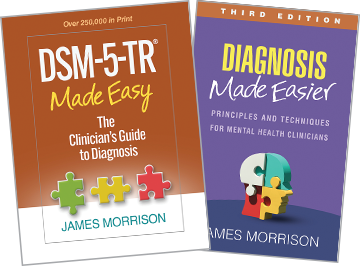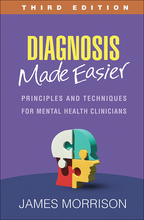Diagnosis Made Easier
Third Edition
Principles and Techniques for Mental Health Clinicians
James Morrison
HardcoverPaperbacke-bookprint + e-book
Hardcover
orderJanuary 15, 2024
ISBN 9781462553419
Price: $68.00 348 Pages
Size: 6" x 9"
Paperback
orderJanuary 4, 2024
ISBN 9781462553402
Price: $45.00348 Pages
Size: 6" x 9"
e-book
orderDecember 22, 2023
PDF and Accessible ePub ?
Price: $45.00 348 Pages
ePub is Global Certified Accessible
print + e-book $90.00 $54.00
orderPaperback + e-Book (PDF and Accessible ePub) ?
Price: 348 Pages
ePub is Global Certified Accessible
Check out a special package offer including this title!

Read a Q&A with featured author, James Morrison!
Sign up for emails on upcoming titles by James Morrison (with special discounts)!
Sign up for emails on upcoming titles by James Morrison (with special discounts)!
The third edition of this incisive practitioner resource and course text—updated for the DSM-5 Text Revision (DSM-5-TR)—takes the reader step by step through diagnostic decision making in mental health. Guidelines are presented for evaluating information from multiple sources, constructing a wide-ranging differential diagnosis, creating a safety hierarchy, and using decision trees to derive a valid working diagnosis. The book addresses specific issues in diagnosing the conditions most often seen in mental health practice, with an emphasis on how diagnosis informs effective treatment. More than 100 vivid vignettes illustrate the diagnostic process and allow readers to practice their skills.
New to This Edition
New to This Edition
- Revised throughout for DSM-5-TR, including the new diagnosis of prolonged grief disorder.
- Chapter on eating and sleeping disorders, including new decision trees.
- New and updated vignettes and suggested readings.



